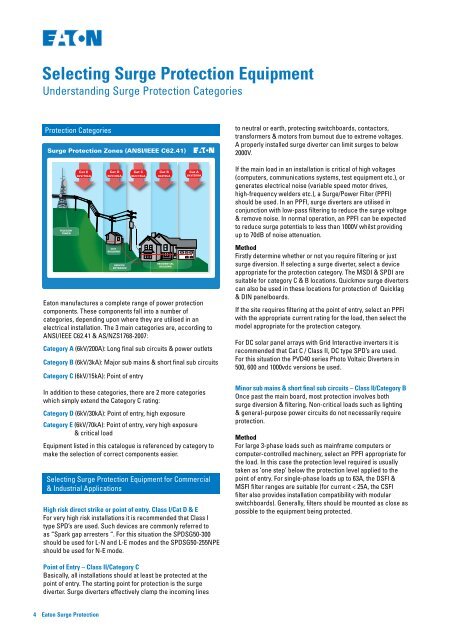Low Voltage Surge Protection - Powerware
Low Voltage Surge Protection - Powerware
Low Voltage Surge Protection - Powerware
Create successful ePaper yourself
Turn your PDF publications into a flip-book with our unique Google optimized e-Paper software.
4<br />
Selecting <strong>Surge</strong> <strong>Protection</strong> Equipment<br />
Understanding <strong>Surge</strong> <strong>Protection</strong> Categories<br />
<strong>Protection</strong> Categories<br />
<strong>Surge</strong> <strong>Protection</strong> Zones (ANSI/IEEE C62.41)<br />
TELECOM<br />
TOWER<br />
Cat E<br />
6kV/70kA<br />
Eaton manufactures a complete range of power protection<br />
components. These components fall into a number of<br />
categories, depending upon where they are utilised in an<br />
electrical installation. The 3 main categories are, according to<br />
ANSI/IEEE C62.41 & AS/NZS1768-2007:<br />
Category A (6kV/200A): Long final sub circuits & power outlets<br />
Category B (6kV/3kA): Major sub mains & short final sub circuits<br />
Category C (6kV/15kA): Point of entry<br />
In addition to these categories, there are 2 more categories<br />
which simply extend the Category C rating:<br />
Category D (6kV/30kA): Point of entry, high exposure<br />
Category E (6kV/70kA): Point of entry, very high exposure<br />
& critical load<br />
Equipment listed in this catalogue is referenced by category to<br />
make the selection of correct components easier.<br />
Selecting <strong>Surge</strong> <strong>Protection</strong> Equipment for Commercial<br />
& Industrial Applications<br />
High risk direct strike or point of entry. Class I/Cat D & E<br />
For very high risk installations it is recommended that Class I<br />
type SPD’s are used. Such devices are commonly referred to<br />
as “Spark gap arresters “. For this situation the SPDSG50-300<br />
should be used for L-N and L-E modes and the SPDSG50-255NPE<br />
should be used for N-E mode.<br />
Point of Entry – Class II/Category C<br />
Basically, all installations should at least be protected at the<br />
point of entry. The starting point for protection is the surge<br />
diverter. <strong>Surge</strong> diverters effectively clamp the incoming lines<br />
Eaton <strong>Surge</strong> <strong>Protection</strong><br />
Cat D<br />
6kV/30kA<br />
OUT<br />
BUILDING<br />
SERVICE<br />
ENTRANCE<br />
Cat C<br />
6kV/15kA<br />
Cat B<br />
6kV/3kA<br />
RESIDENTIAL<br />
BUILDING<br />
Cat A<br />
6kV/200A<br />
to neutral or earth, protecting switchboards, contactors,<br />
transformers & motors from burnout due to extreme voltages.<br />
A properly installed surge diverter can limit surges to below<br />
2000V.<br />
If the main load in an installation is critical of high voltages<br />
(computers, communications systems, test equipment etc.), or<br />
generates electrical noise (variable speed motor drives,<br />
high-frequency welders etc.), a <strong>Surge</strong>/Power Filter (PPFI)<br />
should be used. In an PPFI, surge diverters are utilised in<br />
conjunction with low-pass filtering to reduce the surge voltage<br />
& remove noise. In normal operation, an PPFI can be expected<br />
to reduce surge potentials to less than 1000V whilst providing<br />
up to 70dB of noise attenuation.<br />
Method<br />
Firstly determine whether or not you require filtering or just<br />
surge diversion. If selecting a surge diverter, select a device<br />
appropriate for the protection category. The MSDI & SPDI are<br />
suitable for category C & B locations. Quickmov surge diverters<br />
can also be used in these locations for protection of Quicklag<br />
& DIN panelboards.<br />
If the site requires filtering at the point of entry, select an PPFI<br />
with the appropriate current rating for the load, then select the<br />
model appropriate for the protection category.<br />
For DC solar panel arrays with Grid Interactive inverters it is<br />
recommended that Cat C / Class II, DC type SPD’s are used.<br />
For this situation the PVD40 series Photo Voltaic Diverters in<br />
500, 600 and 1000vdc versions be used.<br />
Minor sub mains & short final sub circuits – Class II/Category B<br />
Once past the main board, most protection involves both<br />
surge diversion & filtering. Non-critical loads such as lighting<br />
& general-purpose power circuits do not necessarily require<br />
protection.<br />
Method<br />
For large 3-phase loads such as mainframe computers or<br />
computer-controlled machinery, select an PPFI appropriate for<br />
the load. In this case the protection level required is usually<br />
taken as ‘one step’ below the protection level applied to the<br />
point of entry. For single-phase loads up to 63A, the DSFI &<br />
MSFI filter ranges are suitable (for current < 25A, the CSFI<br />
filter also provides installation compatibility with modular<br />
switchboards). Generally, filters should be mounted as close as<br />
possible to the equipment being protected.


